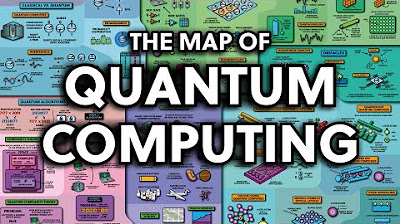mod03lec18 - Grover's algorithm Programming
Summary
TLDRThis video tutorial delves into the implementation of Grover's search algorithm using Qiskit, a quantum computing framework. The presenter guides viewers through creating a quantum circuit to search for an element in an array of size 16 using a 4-qubit register. The tutorial covers the creation of a phase oracle, the application of multi-controlled Toffoli gates, and the reflection about the uniform superposition state. It also explores iteratively applying Grover's oracle and reflection to increase the probability of measuring the marked element. The session concludes with a discussion on the algorithm's effectiveness and ponders future considerations like handling multiple marked elements and unknown quantities.
Takeaways
- 🔍 The video discusses the implementation of Grover's search algorithm using Qiskit, a Python library for quantum computing.
- 🧩 The example focuses on searching for an element in an array of size 16, which can be addressed using a 4-qubit register.
- 🌐 An ancillary qubit is required to store the state |-⟩, which is used to convert a standard oracle into a phase oracle.
- 🔑 Grover's algorithm involves creating a superposition of all states, applying the oracle, and reflecting about the uniform superposition state.
- 🎯 The oracle function, represented as f(x), is crucial for identifying the marked element, which is the element we are searching for.
- 🤔 The implementation of the oracle is demonstrated, showing how to use a multi-controlled Toffoli gate to achieve the desired functionality.
- 📊 The video uses a state vector simulator to visualize the state of the qubits throughout the algorithm's execution.
- 📉 The script includes a step-by-step guide on how to apply Grover's algorithm iteratively, including the use of phase oracles and reflections.
- 📊 A histogram is used to show the probability distribution of measured states, highlighting the marked element with the highest probability.
- 🔮 The video concludes with considerations for future exploration, such as handling multiple marked elements and scenarios where the number of elements is unknown.
Q & A
What is the primary focus of the video script?
-The primary focus of the video script is the implementation of Grover's search algorithm using Qiskit, a Python library for working with quantum computers.
What is the size of the array that Grover's search is applied to in the script?
-In the script, Grover's search is applied to an array of size 16, with indices labeled from 0 to 15.
How many qubits are required to address elements in an array of size 16?
-Four qubits are required to address elements in an array of size 16, as 4 qubits can address elements from 0 to 2^4 - 1, which is 15.
What is the purpose of the ancillary qubit in the Grover's search circuit?
-The ancillary qubit is used to store the state |-⟩ and is necessary to turn the standard oracle into a phase oracle, which is a requirement for Grover's search algorithm.
What is the marked element in the Grover's search example provided in the script?
-The marked element in the Grover's search example is the element with index 13, which is represented by the bits 1 0 1 1 in reverse order due to Qiskit's least significant bit to most significant bit ordering.
What is the role of the oracle function in Grover's search?
-The oracle function in Grover's search is represented by a function f(x), which is 1 if x is the marked element and 0 otherwise. It is implemented as a unitary operation that flips the phase of the marked state.
What is a multi-controlled Toffoli gate and how is it used in the script?
-A multi-controlled Toffoli gate is a quantum gate that takes multiple control qubits and a single target qubit. If all control qubits are in state |1⟩, it flips the state of the target qubit. In the script, it is used to implement the oracle for Grover's search.
How is the reflection about the uniform superposition state achieved in the script?
-The reflection about the uniform superposition state is achieved by first rotating the uniform superposition state to the state of all zeros using Hadamards, then reflecting about the state of all zeros, and finally rotating back to the uniform superposition state.
What is the initial state of the qubits in the Grover's search circuit as described in the script?
-The initial state of the qubits in the Grover's search circuit is a uniform superposition of all states for the first n qubits, and the final qubit is in the state |-⟩.
How does the script visualize the state of the qubits during Grover's search?
-The script visualizes the state of the qubits by projecting the state vector onto the 2D plane spanned by the marked state |a⟩ and the uniform superposition of unmarked states |e⟩, and then plotting the projection.
What is the outcome of running Grover's search algorithm as described in the script?
-The outcome of running Grover's search algorithm as described in the script is that the highest probability measurement is the marked element, which is |1011⟩ in this case, demonstrating the effectiveness of Grover's algorithm.
Outlines

This section is available to paid users only. Please upgrade to access this part.
Upgrade NowMindmap

This section is available to paid users only. Please upgrade to access this part.
Upgrade NowKeywords

This section is available to paid users only. Please upgrade to access this part.
Upgrade NowHighlights

This section is available to paid users only. Please upgrade to access this part.
Upgrade NowTranscripts

This section is available to paid users only. Please upgrade to access this part.
Upgrade NowBrowse More Related Video

mod03lec16 - Quantum Algorithms: Bernstein Vazirani Algorithm

mod02lec12 - Quantum Computing Concepts: Entanglement and Interference - Part 2

Where my explanation of Grover’s algorithm failed

How to program a quantum computer using Qiskit

Computação Quântica - Fundamentos e Aplicações - Aula 06

The Map of Quantum Computing - Quantum Computing Explained
5.0 / 5 (0 votes)